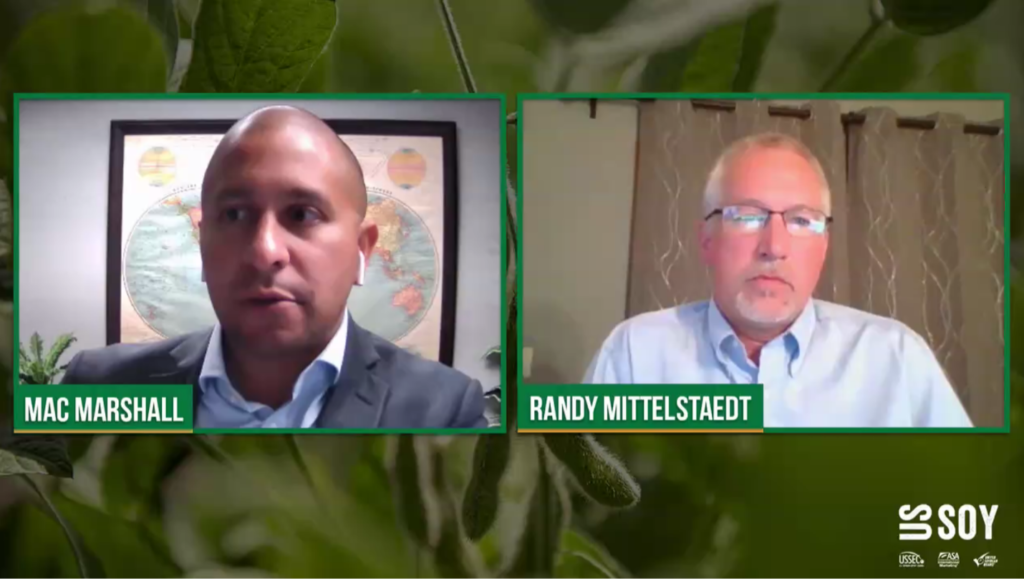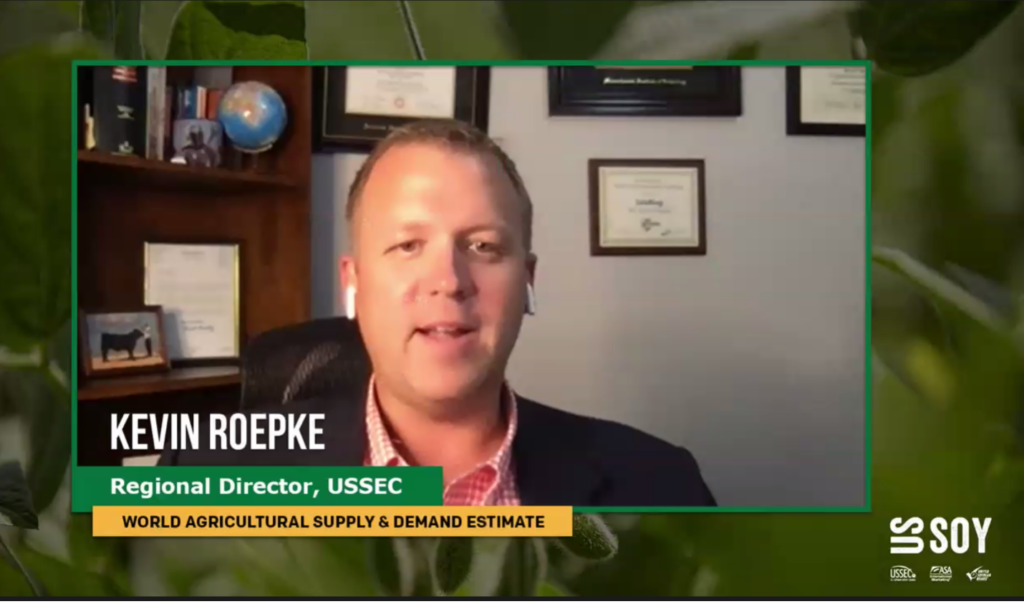
As USDA lifts U.S. Soy yield projections, tension loosens on tight global balance sheet for supply and demand.
U.S. Department of Agriculture economists lift estimates for average U.S. soy yield by roughly 2% from September. If realized, U.S. soybean farmers will harvest a record crop of 4.45 billion bushels, or 121 MMT, smashing production numbers from 2018.
These numbers and more were part of last night’s discussion as analysts and industry experts convened for the U.S. Soy WASDE Update just after the release of USDA’s October World Agricultural Supply and Demand Estimates report.
“I’m pleased to see USDA’s upward revision for the 2021 crop, as well as the 2020 crop,” says U.S. Soybean Export Council CEO Jim Sutter, who explains that it’s been a difficult past six to 12 months. “High prices have forced many customers around the world to make tough decisions and tighten their belt and look at different ways of doing things.
“I think that makes us all better, we’ll all be better off with a bigger supply to work from as we continue to see demand growing around the world … and we want to continue supplying that demand.”

Sutter was joined by Mac Marshall, who serves as Vice President of Market Intelligence for USSEC and the United Soybean Board; R.J. O’Brien’s Randy Mittelstaedt, Head of Market Insights; and USSEC Regional Director Kevin Roepke, South Asia and Sub-Sahara Africa.

While it’s unusual to see USDA shift numbers this much from one report to the next, both Marshall and Mittelstaedt agree it’s on trend that “big crops tend to get bigger.”
Mittelstaedt says one reason for a jump of this size from the September to the October report is likely the advanced maturity of this year’s soybean crop when USDA did their analysis.
“We typically don’t see that for another month,” he says. “I think the advanced maturity of the crop really helps solidify these numbers, as well.”
Additionally, USDA’s projections for the U.S. oil balance sheet may have surprised some in the market.
“I did not expect to see upward revisions in this marketing year or in the prior marketing year, that’s introducing a higher carryout,” Marshall says.
Mittelstaedt agrees: “We are in an interesting position as we look at the U.S. oil balance sheet. The last couple of months’ crush reports have shown bean oil stocks higher than general expectations.
“… The bottom line is that domestic usage of soybean oil has been weaker than expected over the past couple of months. This has forced USDA to make upward revisions to ending stocks and downward revisions to usage. Quite frankly, those domestic usage downward revisions over the past couple months have been impressive; they’ve cut almost 575 million pounds out of domestic usage just over the past three WASDE reports.”
Oil Market Complex
When we look at the discussions going on around renewable diesel and soybean oil, Mittelstaedt says there’s fixed crush capacity in the United States.
“It is growing,” he says. “We’ve seen the announcements of crush plants being expanded and new facilities to be constructed, but again these take time.”
Mittelstaedt says as he looks back at the record crush numbers from the previous October/November/December and applies them on an annualized basis, he can work through a crush capacity number between 2.35 billion bushels and 2.5 billion bushels. USDA today is at 2.19 billion bushels.
“If we look at that, we might be within 35-40 million bushels on an annualized crush capacity basis already,” Mittelstaedt says. “We need to get more capacity on stream if we are going to see the types of renewable diesel numbers being talked about.”
Roepke calls out that as we look at the global oil complex, one cannot exclude India and South Asia from the discussion.
“India is the No. 1 importer of soybean oil in the world — three times larger than China,” Roepke says. “As such, importers are watching vegetable oil prices quite closely. Palm oil prices are also quite high; it’s not just soybean oil, energy prices also come into play.”
Looking forward, Roepke asks: With the anticipated spike in renewable diesel demand, what will be the implication of the soybean meal market and how will we look at markets that may be seen as potential markets for soybean meal?
He explains India may benefit from the broader dynamics at play.
“India has an urbanization rate of 30-35%, growing at a rate of .5% per year,” Roepke says. “When compared to China at 60-65%, we see India still has a long way to go in terms of urbanization. Urbanization is a tremendous leading indicator for India’s potential for animal proteins and vegetable oil consumption.”
Plus, with the country’s recent developments in temporarily accepting imports of soybean meal from Bangladesh, Argentina and Vietnam, there is tremendous opportunity for U.S. Soy, he says.
And the country with the world’s fastest growing population could benefit from global dynamics: U.S. increasing renewable fuel production, lower hog and pig inventories in the U.S., liquidations of hog inventories in China, and lower domestic consumption of soybean meal.
With the anticipated increase in crush, Marshall says the market can expect more soybean meal to buy.
Mittelstaedt adds that when you couple the above with the impact of COVID-19 (decreased demand for gasoline and the subsequent pull back in ethanol production and DDGs) and both ramping up, it will have a bit of a double impact.
The bottom line, Mittelstaedt says, is that during the next 12 months, the United States will be heavy on the meal side and exports represent an opportunity to move meal and for buyers and livestock operations to take advantage of the changing dynamics.
Check out the video below for more insights and perspective.
— Partially funded by U.S. soybean farmers and their checkoff.